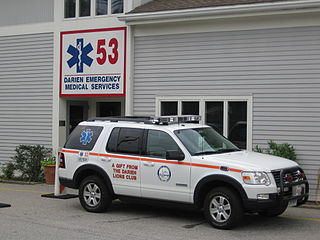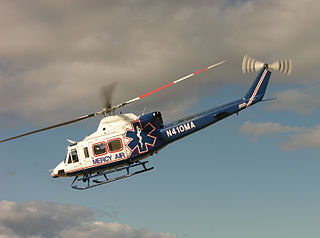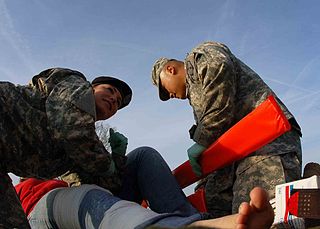
Emergency medical services (EMS), also known as ambulance services or paramedic services, are emergency services that provide urgent pre-hospital treatment and stabilisation for serious illness and injuries and transport to definitive care. They may also be known as a first aid squad, FAST squad, emergency squad, ambulance squad, ambulance corps, life squad or by other initialisms such as EMAS or EMARS.

An emergency medical technician is a medical professional that provides emergency medical services. EMTs are most commonly found serving on ambulances and in fire departments in the US and Canada, as full-time and some part-time departments require their firefighters to at least be EMT certified.

A paramedic is a healthcare professional trained in the medical model, whose main role has historically been to respond to emergency calls for medical help outside of a hospital. Paramedics work as part of the emergency medical services (EMS), most often in ambulances. They also have roles in emergency medicine, primary care, transfer medicine and remote/offshore medicine. The scope of practice of a paramedic varies between countries, but generally includes autonomous decision making around the emergency care of patients.
ARCH Air Medical Service is an emergency medical service (EMS) that provides critical care air ambulance service in Missouri, Illinois, and the surrounding regions. Air ambulance programs offer transport by helicopter (rotor-wing) or fixed-wing aircraft. ARCH Air was the twelfth program in the U.S. to offer such services when it began operating in March 1979. Transporting approximately 4,200 patients per year by helicopter, ARCH aircraft are staffed by a pilot, nurse and paramedic. Flights are 80% inter-facility and 20% scene.

In the United States, the paramedic is an allied health professional whose primary focus is to provide advanced emergency medical care for patients who access Emergency Medical Services (EMS). This individual possesses the complex knowledge and skills necessary to provide patient care and transportation. Paramedics function as part of a comprehensive EMS response under physician medical direction. Paramedics often serve in a prehospital role, responding to Public safety answering point (9-1-1) calls in an ambulance. The paramedic serves as the initial entry point into the health care system. A standard requirement for state licensure involves successful completion of a nationally accredited Paramedic program at the certificate or associate degree level.

The Shock Trauma Air Rescue Service is a Canadian non-profit helicopter air ambulance organization funded by individual donors, service groups, corporate donors and government contributions. STARS provides rapid and specialized emergency care and transportation for critically ill and injured patients. STARS operates from bases in Calgary, Edmonton, Grande Prairie, Regina, Saskatoon, Winnipeg and formerly Halifax.
Acadian Ambulance is an employee-owned private ambulance service that covers most of the state of Louisiana, a large portion of Texas, two counties in Tennessee, and one county in Mississippi. In 1995 it was recognized as the largest privately owned ambulance service in the United States. Today the company responds to emergency and non-emergency calls in Louisiana; Southeast, Central, and North Texas; Jackson County, Mississippi; Nashville and Memphis, Tennessee.
Flight for Life is a prehospital care service with many bases of operation across the United States. Flight for Life is primarily known for its emergency medical helicopter transport, but also operates a fleet of land vehicles and fixed-wing aircraft for the transport of critically ill patients to specialized medical care. Helicopter transport is normally reserved for the most critically injured patients or patients who cannot be reached by traditional means of Emergency medical services. Helicopter transport is also especially useful for the transport of critically wounded patients to specialty medical facilities, such as burn, pediatric, or advanced trauma centers, that may be further away from the location of injury. Many rural communities rely on the speed of the helicopter to reach and evacuate their most serious patients to an available medical center. The helicopter may also be used for search and rescue operations in conjunction with ground units or alone.

The Center for Emergency Medicine of Western Pennsylvania is a multi-hospital consortium based in Pittsburgh, Pennsylvania. It is claimed to be one of the world's premiere centers of Emergency Medicine and EMS development. It currently ranks sixth for residencies in emergency medicine by reputation.

In the United States, emergency medical services (EMS) provide out-of-hospital acute medical care and/or transport to definitive care for those in need. They are regulated at the most basic level by the National Highway Traffic Safety Administration, which sets the minimum standards that all states' EMS providers must meet, and regulated more strictly by individual state governments, which often require higher standards from the services they oversee.
Emergency Medical Service in Germany is a service of public pre-hospital emergency healthcare, including ambulance service, provided by individual German cities and counties. It is primarily financed by the German public health insurance system.
Emergency medical services in Norway are operated both by the government and private organizations such as the Norwegian People's Aid, the Norwegian Red Cross and commercial transportation companies. In most circumstances, emergency ambulance service is organized by a local Health Trust, and may be operated directly, or contracted to private providers, such as national transportation companies, for which ambulances are just a part of their business operations. Private organisations are also used frequently by the police in search & rescue operations.

The safety of emergency medical services flights has become a topic of public interest in the United States, with the expansion of emergency medical services aviation operations, such as air ambulance and MEDEVAC, and the increasing frequency of related accidents.

Emergency Medical Responders (EMRs) are people who are specially trained to provide out-of-hospital care in medical emergencies, typically before the arrival of an ambulance. Specifically used, an emergency medical responder is an EMS certification level used to describe a level of EMS provider below that of an emergency medical technician and paramedic. However, the EMR is not intended to replace the roles of such providers and their wide range of specialties.
Air ambulances in the United States are operated by a variety of hospitals, local government agencies, and for-profit companies. Medical evacuations by air are also performed by the United States Armed Forces and United States National Guard.
Emergency medical services in Iceland include the provision of ambulance service. They provide all emergency ambulance service for a population of in excess of 320,000 people in one of the most sparsely settled countries in Europe. The system is government-funded for the first 85 percent of cost, with 15 percent being charged to the individual as a deterrent fee. All services in Iceland are provided by the Icelandic Red Cross, with individual ambulances often co-located with local fire brigades.
Air Evac EMS, Inc., operating as Air Evac Lifeteam and sometimes called simply Air Evac, is an American helicopter emergency medical service (HEMS) or air ambulance provider headquartered in O'Fallon, Missouri. It is the largest subsidiary of Global Medical Response, though still considered an independent provider. It is also the largest membership-supported air ambulance service in the US operating helicopters from 140 bases in 15 states, mostly in the central and southern regions of the country. While primarily a HEMS provider, it also operates 2 fixed-wing aircraft in Missouri and Kentucky.

Air medical services are the use of aircraft, including both fixed-wing aircraft and helicopters to provide various kinds of urgent medical care, especially prehospital, emergency and critical care to patients during aeromedical evacuation and rescue operations.

Ukiah Ambulance is now Medstar Ambulance of Mendocino County Inc., a private non-profit ground transport ambulance provider serving central and southern Mendocino County. It is the longest continuously running ambulance service in Mendocino County history. Ukiah Ambulance also developed the first air rescue service in Mendocino County, called FlightCare, which operated for ten years out of the Ukiah Municipal Airport.
Life Flight Network is a non profit air and ground critical care transport service based in Aurora, Oregon, in the northern Willamette Valley, with services in Oregon, Washington, Idaho, and Montana in the United States.









